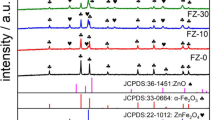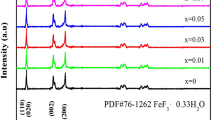Abstract
Partial manganese substitution of iron in ferrous carbonate (Mn x Fe1−x CO3, x = 0, 0.1, 0.2, 0.3) is obtained via a one-step hydrothermal method. The phase structure, morphology, and structural stability are characterized by X-ray diffraction (XRD), scanning electron microscopy (SEM), and thermogravimetric analysis, respectively. The results of XRD demonstrate that Mn-doping does not obviously change the phase structure. Mn x Fe1−x CO3 possesses cockscomb-like and tunnel structures observed by SEM images. Meanwhile, the results of XPS further demonstrate the existence of Fe2+ and Mn2+. Mn-doped FeCO3 samples remarkably improve galvanostatic charge–discharge stability and rate capability as anode materials for lithium-ion batteries because of the synergistic behavior of Fe2+ and Mn2+ with cockscomb-like and tunnel structures. Mn x Fe1−x CO3 (x = 0.2) as an anode material delivers an initial specific discharge capacity of 2400 mAh g−1 at 200 mA g−1 and 904 mAh g−1 over 100 cycles. Therefore, Mn x Fe1−x CO3 anode materials are promising for lithium-ion batteries because of their low-cost preparation, environmentally friendly nature, and excellent electrochemical performance.
Graphical Abstract








Similar content being viewed by others
References
Yoshino A (2012) The birth of the lithium-ion battery. Angew Chem Int Edit 51:5798–5800
Nitta N, Wu F, Lee JT et al (2015) Li-ion battery materials: present and future. Mater Today 18:252–264
Goodenough JB, Kim Y (2010) Challenges for rechargeable Li batteries. Chem Mater 22:587–603
Abada S, Marlair G, Lecocq A et al (2016) Safety focused modeling of lithium-ion batteries: a review. J Power Sources 306:178–192
Larcher D, Tarascon J (2014) Towards greener and more sustainable batteries for electrical energy storage. Nat Chem 7:19–29
Raccichini R, Varzi A, Passerini S et al (2014) The role of graphene for electrochemical energy storage. Nat Mater 14:271–279
Fan X, Li S, Zhou H et al (2015) One-pot high temperature hydrothermal synthesis of Fe3O4@C/graphene nanocomposite as anode for high rate lithium ion battery. Electrochim Acta 180:1041–1049
Magasinski A, Dixon P, Hertzberg B et al (2010) High-performance lithium-ion anodes using a hierarchical bottom-up approach. Nat Mater 9:353–358
Qian J, Henderson WA, Xu W et al (2015) High rate and stable cycling of lithium metal anode. Nat Commun 6:6362–6370
Zhang W, Li M, Wang Q et al (2011) Hierarchical self-assembly of microscale cog-like superstructures for enhanced performance in lithium-ion batteries. Adv Funct Mater 21:3516–3523
Zaghib K, Simoneau M, Armand M et al (1999) Electrochemical study of Li4Ti5O12 as negative electrode for Li-ion polymer rechargeable batteries. J Power Sources 81–82:300–305
Ge H, Li N, Li D et al (2009) Study on the theoretical capacity of spinel lithium titanate induced by low-potential intercalation. J Phys Chem C 113:6324–6326
Xiu Z, Alfaruqi MH, Gim J et al (2016) MOF-derived mesoporous anatase TiO2 as anode material for lithium-ion batteries with high rate capability and long cycle stability. J Alloys Compd 674:174–178
Hassoun J, Derrien G, Panero S et al (2008) A nanostructured Sn-C composite lithium battery electrode with unique stability and high electrochemical performance. Adv Mater 20:3169–3175
Lou XW, Wang Y, Yuan C et al (2006) Template-free synthesis of SnO2 hollow nanostructures with high lithium storage capacity. Adv Mater 18:2325–2329
Zhao B, Huang S, Wang T et al (2015) Hollow SnO2@Co3O4 core–shell spheres encapsulated in three-dimensional graphene foams for high performance supercapacitors and lithium-ion batteries. J Power Sources 298:83–91
Jia H, Stock C, Kloepsch R et al (2015) Facile synthesis and lithium storage properties of a porous NiSi2/Si/carbon composite anode material for lithium-ion batteries. ACS Appl Mater Interfaces 7:1508–1515
Rahman MA, Song G, Bhatt AI et al (2016) Nanostructured silicon anodes for high-performance lithium-ion batteries. Adv Funct Mater 26:647–678
Jiang Y, Li Z, Li B et al (2016) Ni3Si2 nanowires grown in situ on Ni foam for high-performance supercapacitors. J Power Sources 320:13–19
Zhang K, Li P, Ma M et al (2016) Core-shelled low-oxidation state oxides@reduced graphene oxides cubes via pressurized reduction for highly stable lithium ion storage. Adv Funct Mater 26:2959–2965
Sen UK, Shaligram A, Mitra S (2014) Intercalation anode material for lithium ion battery based on molybdenum dioxide. ACS Appl Mater Interfaces 6:14311–14319
Liu Y, Zhang N, Yu C et al (2016) MnFe2O4@C nanofibers as high-performance anode for sodium-ion batteries. Nano Lett 16:3321–3328
Liu W, Yang H, Zhao L et al (2016) Mesoporous flower-like Co3O4/C nanosheet composites and their performance evaluation as anodes for lithium ion batteries. Electrochim Acta 207:293–300
Zheng X, Wang H, Wang C et al (2016) 3D interconnected macro-mesoporous electrode with self-assembled NiO nanodots for high-performance supercapacitor-like Li-ion battery. Nano Energy 22:269–277
Bock DC, Pelliccione CJ, Zhang W et al (2016) Dispersion of nanocrystalline Fe3O4 within composite electrodes: insights on battery-related electrochemistry. ACS Appl Mater Interfaces 8:11418–11430
Hu S, Yin F, Uchaker E et al (2014) Facile and green preparation for the formation of MoO2-GO composites as anode material for lithium-ion batteries. J Phys Chem C 118:24890–24897
Aragón MJ, Pérez-Vicent C, Tirado JL (2007) Submicronic particles of manganese carbonate prepared in reverse micelles: a new electrode material for lithium-ion batteries. Electrochem Commun 9:1744–1748
Shao L, Ma R, Wu K et al (2013) Metal carbonates as anode materials for lithium ion batteries. J Alloys Compd 581:602–609
Zhao S, Yu Y, Wei S et al (2014) Hydrothermal synthesis and potential applicability of rhombohedral siderite as a high-capacity anode material for lithium ion batteries. J Power Sources 253:251–255
Zhang R, Zhang F, Feng J et al (2014) Green and facile synthesis of porous ZnCO3 as a novel anode material for advanced lithium-ion batteries. Mater Letters 118:5–7
Han W, Yang K, Li D et al (2016) The fabrication and characterization of Zn5(CO3)2(OH)6 as a new anode material for lithium ion batteries. Mater Letters 164:148–151
Shao L, Wu K, Jiang X et al (2014) Preparation and characterization of basic carbonates as novel anode materials for lithium-ion batteries. Ceram Int 40:3105–3116
Shao L, Wang S, Wu K et al (2014) Comparison of (BiO)2CO3 to CdCO3 as anode materials for lithium-ion batteries. Ceram Int 40:4623–4630
Zhang C, Liu W, Chen D et al (2015) One step hydrothermal synthesis of FeCO3 cubes for high performance lithium-ion battery anodes. Electrochim Acta 182:559–564
Zhong Y, Su L, Yang M et al (2013) Rambutan-like FeCO3 hollow microspheres: facile preparation and superior lithium storage performances. ACS Appl Mater Interfaces 5:11212–11217
Ding Z, Yao B, Feng J et al (2013) Enhanced rate performance and cycling stability of a CoCO3–polypyrrole composite for lithium ion battery anodes. J Mater Chem A 1:11200–11209
Kesavan T, Suresh S, Arulraj I et al (2014) Facile synthesis of hollow sphere MnCO3: a cheap and environmentally benign anode material for Li-ion batteries. Mater Lett 136:411–415
Wang S, Li Q, Pu W et al (2016) Development of monodispersed MnCO3/graphene nanosheet composite as anode for lithium-ion battery by hydrothermal synthesis. Ionics 22:771–778
Sharma Y, Sharma N, Rao GVS et al (2009) Nano-(Cd1/3Co1/3Zn1/3)CO3: a new and high capacity anode material for Li-ion batteries. J Mater Chem 19:5047
Su L, Zhou Z, Qin X, Tang Q, Wu D, Shen P (2013) CoCO3 submicrocube/graphene composites with high lithium storage capability. Nano Energy 2:276–282
Zhang F, Zhang R, Feng J et al (2015) One-pot solvothermal synthesis of graphene wrapped rice-like ferrous carbonate nanoparticles as anode materials for high energy lithium-ion batteries. Nanoscale 7:232–239
Mirhashemihaghighi S, León B, Vicente CP et al (2012) Lithium storage mechanisms and effect of partial cobalt substitution in manganese carbonate electrodes. Inorg Chem 51:5554–5560
Pertlik F (1986) Structures of hydrothermally synthesized cobalt(II) carbonate and nickel(II) carbonate. Acta Cryst C42:4–5
Zhao S, Yu Y, Wei S et al (2014) Hydrothermal synthesis and potential applicability of rhombohedral siderite as a high-capacity anode material for lithium ion batteries. J Power Sources 253:251–255
Sun Y, Hu X, Luo W et al (2013) Reconstruction of conformal nanoscale MnO on graphene as a high-capacity and long-life anode material for lithium ion batteries. Adv Funct Mater 23:2436–2444
Garakani MA, Abouali S, Zhang B et al (2014) Cobalt carbonate/and cobalt oxide/graphene aerogel composite anodes for high performance li-ion batteries. ACS Appl Mater Interfaces 6:18971–18980
Li Z, Liu N, Wang X et al (2012) Three-dimensional nanohybrids of Mn3O4/ordered mesoporous carbons for high performance anode materials for lithium-ion batteries. J Mater Chem 22:16640–16648
Jiang J, Li Y, Liu J et al (2012) Recent advances in metal oxide-based electrode architecture design for electrochemical energy storage. Adv Mater 24:5166–5180
Ponrouch A, Taberna P, Simon P et al (2012) On the origin of the extra capacity at low potential in materials for Li batteries reacting through conversion reaction. Electrochim Acta 61:13–18
Shim H, Jin Y, Seo S et al (2011) Highly reversible lithium storage in bacillus subtilis-directed porous Co3O4 nanostructures. ACS Nano 5:443–449
Wang X, Guan H, Chen S et al (2011) Self-stacked Co3O4 nanosheets for high-performance lithium ion batteries. Chem Commun 47:12280–12282
Liu S, Zhang H, Xu L et al (2016) High lithium storage performance of Mn-doped Sn4P3 nanoparticles. Electrochim Acta 210:888–896
Guo M, Wang S, Ding L et al (2015) Tantalum-doped lithium titanate with enhanced performance for lithium-ion batteries. J Power Sources 283:372–380
Luo G, Lu Y, Zeng S et al (2015) Synthesis of rGO-Fe3O4-SnO2-C quaternary hybrid mesoporous nanosheets as a high-performance anode material for lithium ion batteries. Electrochim Acta 182:715–722
Acknowledgements
This research was supported financially by the Guangdong Science and Technology Planning Project (No. 2015A020209147 and 2014A010105038), the Guangdong Natural Science Foundation (No.9151064201000039), the National Natural Science Foundation of China (No. 51003034 and 21571066), and the Key Academic Program of the 3rd Phase ‘211 Project’ (No. 2009B010100001).
Author information
Authors and Affiliations
Corresponding author
Rights and permissions
About this article
Cite this article
Zhang, C., Xu, D., Chen, W. et al. Cockscomb-like Mn-doped Mn x Fe1−x CO3 as anode materials for a high-performance lithium-ion battery. J Appl Electrochem 47, 157–166 (2017). https://doi.org/10.1007/s10800-016-1028-z
Received:
Accepted:
Published:
Issue Date:
DOI: https://doi.org/10.1007/s10800-016-1028-z




